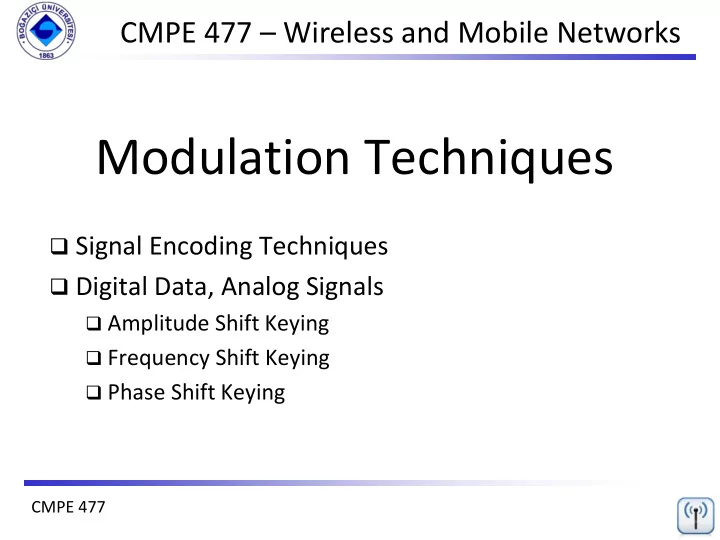

CMPE 477 – Wireless and Mobile Networks Modulation Techniques Signal Encoding Techniques Digital Data, Analog Signals Amplitude Shift Keying Frequency Shift Keying Phase Shift Keying CMPE 477
Analog and Digital Signaling Both digital data and analog data can be represented, hence propagated by either analog or digital signals
Analog and Digital Signaling CMPE 477 1.3
Signal Encoding Criteria What determines how successful a receiver will be in interpreting an incoming signal? Signal-to-noise ratio Data rate Bandwidth An increase in data rate increases bit error rate An increase in SNR decreases bit error rate An increase in bandwidth allows an increase in data rate
Factors Used to Compare Encoding Schemes Signal spectrum With lack of high-frequency components, less bandwidth required Clocking Ease of determining beginning and end of each bit position Signal interference and noise immunity Performance in the presence of noise Cost and complexity The higher the signal rate to achieve a given data rate, the greater the cost
Basic Encoding Techniques Digital data to analog signal Amplitude-shift keying (ASK) Amplitude difference of carrier frequency Frequency-shift keying (FSK) Frequency difference near carrier frequency Phase-shift keying (PSK) Phase of carrier signal shifted
Amplitude-Shift Keying One binary digit represented by presence of carrier, at constant amplitude Other binary digit represented by absence of carrier A cos 2 f t binary 1 c s t binary 0 0 where the carrier signal is A cos(2 π f c t )
Amplitude-Shift Keying t 1 0 1 very simple low bandwidth requirements susceptible to interference Susceptible to sudden gain changes Inefficient modulation technique Used to transmit digital data over optical fiber
Binary Frequency-Shift Keying (BFSK) Two binary digits represented by two different frequencies near the carrier frequency cos A 2 f t binary 1 1 s t cos binary 0 A 2 f t 2 where f 1 and f 2 are offset from carrier frequency f c by equal but opposite amounts 1 0 1 t 1 0 1
Binary Frequency-Shift Keying (BFSK) needs larger bandwidth Less susceptible to error than ASK On voice-grade lines, used up to 1200bps Used for high-frequency (3 to 30 MHz) radio transmission Can be used at higher frequencies on LANs that use coaxial cable
Multiple Frequency-Shift Keying (MFSK) More than two frequencies are used More bandwidth efficient but more susceptible to error i s t A cos 2 f t 1 M i i f i = f c + ( 2i – 1 – M) f d f c = the carrier frequency f d = the difference frequency M = number of different signal elements = 2 L L = number of bits per signal element
Phase-Shift Keying (PSK) Two-level PSK (BPSK) Uses two phases to represent binary digits cos 2 binary 1 A f t c s t binary 0 A cos 2 f t c cos 2 binary 1 A f t c binary 0 A cos 2 f t c 1 0 1 More resistant to interference but receiver and transmitter are also more t complex
Phase-Shift Keying (PSK) Differential PSK (DPSK) Phase shift with reference to previous bit Binary 0 – signal burst of same phase as previous signal burst Binary 1 – signal burst of opposite phase to previous signal burst
Phase-Shift Keying (PSK) Four-level PSK (QPSK) Each element represents more than one bit t 4 A cos 2 f 11 c 3 t 4 A cos 2 f 01 c s t 3 t 4 00 A cos 2 f c t 4 10 cos 2 A f c
Recommend
More recommend